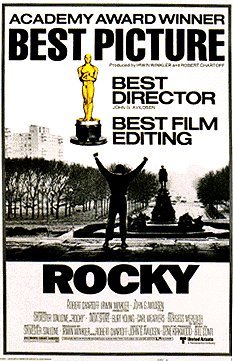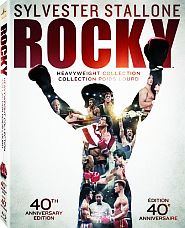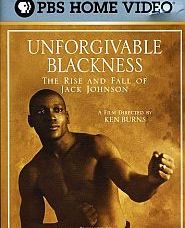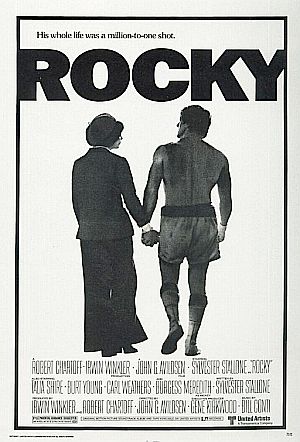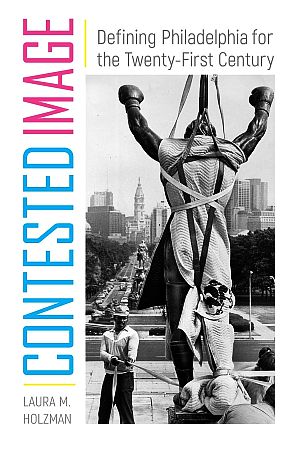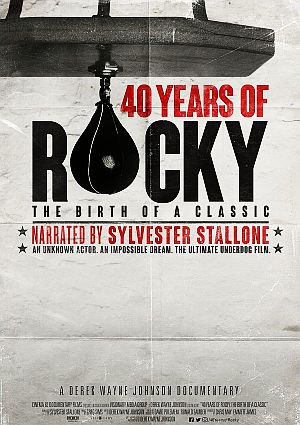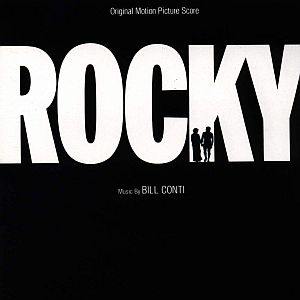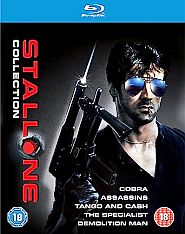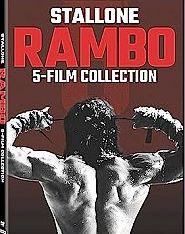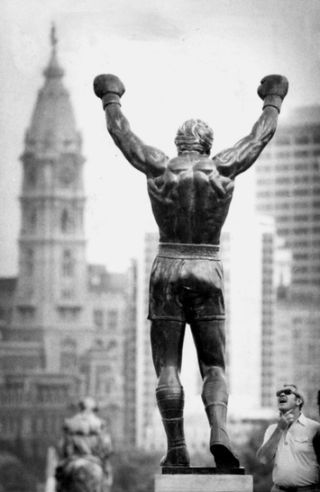
Statue of the famed Rocky Balboa character from the ‘Rocky’ film series, shown here in the early 1980s, in its much-disputed ‘top-of-the-steps’ perch at the Philadelphia Art Museum, looking out on center city. Photo, Vicki Valerio, Philadelphia Inquirer, July 1982.
In the first Rocky movie of 1976-77 — which won the Academy Award for Best Picture — Rocky Balboa, South Philly’s “Italian Stallion,” is a down-and-out heavyweight boxer who is unexpectedly given an opportunity to fight in a world championship bout.
In his training for the big fight, Rocky runs the long series of steps that rise up to the entrance plaza at the Philadelphia Art Museum. The steps climb to a location that also offers one of the finest views of Philadelphia’s skyline.
In the film, Rocky, the underdog and out-of-shape contender, does a daily, pre-dawn “battle with the steps” while the city sleeps. Rocky is “beaten” by the steps day after day, but he keeps at it. Finally, in one scene he triumphs — now becoming fit — shown sprinting to the top of the steps with energy to spare. Having beaten the steps and arriving at the museum’s plaza, he proceeds to do the “champ dance” with relish, arms raised in victory as the camera moves around him capturing the early morning city skyline over his shoulders. It’s a memorable film scene, and one that has survived in the hearts and minds of millions of filmgoers.
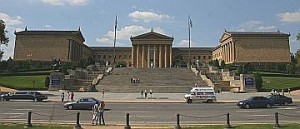
Philadelphia Art Museum and its long series of steps rising to the main entrance - steps now nick-named `the Rocky steps' after the 1976-77 `Rocky' movie. Click for Museum handbook.
In fact, even today, many tourists who come to Philadelphia go to the museum not for the art, but to run “the Rocky steps,” as they are called. Some of those Rocky imitators, reaching their goal, also do the “champ dance” at the top of the steps. There’s even a book about those who come to Philadelphia to run those steps, titled Rocky Stories.
Back in 1982, however, when it came time to finally place the donated “Rocky” statue, the top-of-the-steps location seemed to be the obvious choice — but not for everyone.

Poster from ‘Rocky’ film with Rocky celebrating at Art Museum, looking out on the city. Click for wall art.
“Not Art”
The 12′ – 8″ bronze “Rocky” statue had been commissioned by Sylvester Stallone in 1980 for use in a subsequent Rocky film — Rocky III, which came to theaters around Memorial Day, 1982. In the film, the statue makes its appearance atop the museum steps as part of the film’s storyline when the fictional Rocky champ is honored by the city with a statue dedicated to him at that location.
At the completion of the filming for Rocky III, Stallone left the statue in place as a gift to the city.
As noted above, the top-of-the-steps location at the Philadelphia Art Museum is a choice spot, offering a commanding view of Eakins Oval at the bottom of steps directly in front of the museum (named for Philadelphia resident and artist Thomas Eakins) and the Benjamin Franklin Parkway stretching out toward Philadelphia City Hall.
The Rocky statue remained at this location in 1982 for several months following its use in the Rocky III film. And that’s about when the debate erupted over whether the statue at that location was boon or bane, art or something less than art.
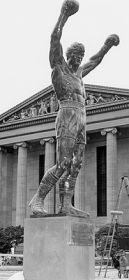
Rocky statue in 1982, atop Philadelphia Art Museum steps.
“Movie Prop”
Philadelphia Commerce Director Dick Doran was thrilled with the statue. In fact, he said that Stallone had done more for the city’s image “than anyone since Ben Franklin.” Others were not similarly enthused. The Philadelphia Art Museum and the Philadelphia Art Commission had some differences over the meaning of “art”. Some regarded the statue as nothing more than a movie prop. Others saw it as kitsch; something garish or as sentimental art; not usually considered in good taste — or as one put it, “should be nowhere near a museum.”
Some museum officials worried the statue could impugn the museum’s international reputation. But others saw a silver lining with the Rocky statue at the museum. “People who had never been inside the museum,” noted one observer, “at least got close to the entrance.” Still others found inspiration in the likeness, pride in their city, a booster for tourism, etc. So, a running debate over the statue’s location continued off and on over the course of 20 years, especially as the statue was moved around.
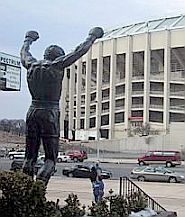
The Rocky statue was moved to Philadelphia’s Spectrum in 1982.
After it was left on the museum’s steps in 1982, the city considered various alternate locations. Several months went by, but the city then settled on an outside location at the front of the Spectrum, an indoor sports arena in South Philadelphia where the Philadelphia 76ers professional basketball team and Philadelphia Flyer’s ice hockey team then played. Rock concerts were also held at the Spectrum. Across the street was Veterans Stadium, home to the Philadelphia Phillies baseball team and Philadelphia Eagles football team. The Spectrum location seemed to make sense since this was the sports area of the city. So, in 1982, after a brief few months at the art museum, the Rocky statue was moved to the Spectrum. Photo at right shows the statue outside the Spectrum front entrance facing Veterans Stadium.
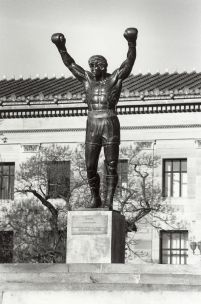
The Rocky statue made a few ‘for-filming-only’ appearances at the Museum location, but remained at the Spectrum through 2002.
In Storage
By 2002, the Rocky statue was put into storage during the demolition of Veterans Stadium and it remained in storage. In August 2005, filming began on the sixth Rocky movie, Rocky Balboa, which was slated for release in 2006, the 30th anniversary of the first Rocky film. Again, folks started talking about moving the Rocky statue back to the Art Museum location. The statue continued to have its supporters and detractors. “If a film about Donald Duck in Philadelphia comes out, do we put a Donald Duck statue in our park system?” asked E. Harris Baum, the city’s park commissioner. “Rocky is fine. But other films have relevance too. Where do we stop?”
Scott Weinberg, a lifelong Philadelphian and self-described “movie geek,” posted this view on the continuing debate in 2006:
“…Give Rocky the spotlight. Sure he’s a fictional character, but this character has done more for this city than the last 11 mayors combined. Ask a guy from California what he knows about Philly, and ‘Rocky’ will be one of his top five answers, guaranteed. So what if the statue was initially created as a movie prop? It’s a pretty impressive piece of work all the same. More importantly, it’s a well-known, well-established, and well-admired symbol of this city, regardless of what the Art Experts have to say on the matter…”
New Location
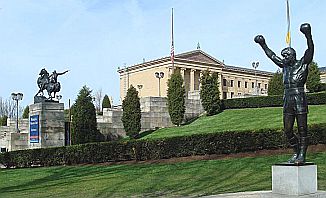
In 2006, the Philadelphia Art Commission approved a location near the Museum for the Rocky statue.
But two Art Commission members had voted against the move — Moe Brooker, artist and professor at Moore College of Art and Design, and University of the Arts President, Miguel Angel Corzo. Both said the move was inappropriate. “It’s not a work of art, and …it doesn’t belong there,” said Brooker. Corzo, who suggested he might resign from the commission over the vote, said placing the statue near the museum ran counter to the commission’s desire to “raise the standards of the city.”
2006 Ceremony
On September 8th, 2006, the Rocky statue was installed at its new location. The unveiling ceremony included live music, the debut of the first full trailer for the Rocky Balboa film, and a free showing of the first Rocky movie from 1976. A cheering crowd of a couple of thousand Rocky fans attended the affair, some traveling quite a distance to be in attendance.
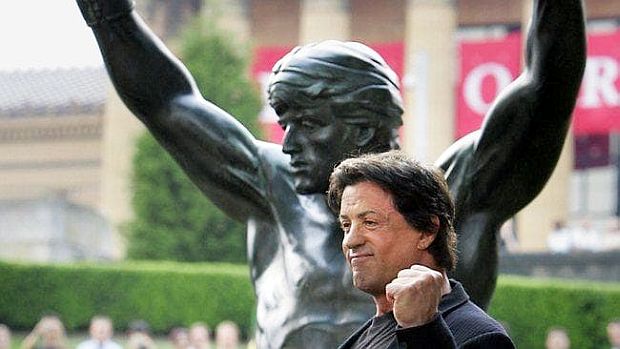
Film star and Rocky creator, Sylvester Stallone, with the Rocky statue at September 8th, 2006 ceremony installing the statue at its new location at the base of the steps to the Philadelphia Museum of Art.
Jason Yun, 28, drove eight hours from Columbus, Ohio to attend the installation ceremony. He was among the first at the barricade surrounding the statue, having slept in his car. “I love Sly,” he told Philadelphia Inquirer reporter Michael Vitez. “He’s my hero,” Yun said. “He’s inspired me to change my lifestyle.” Pamela Weicht, 35, and her husband, Tim, 41, took the day off work and drove to Philly from Camp Hill, PA, near Harrisburg. This couple had played the Rocky III tune, “Eye of the Tiger,” at their wedding. Chet Jelinski, 51, a self-employed carpet cleaner from Bloomfield, New Jersey, and a loyal fan of the Rocky film series, also took day off to come to the event.
|
Statues & Icons This story is one in an occasional series that explores how America and other countries honor their icons — from famous politicians and military leaders, to movie stars, TV celebrities, and sports heroes. Societies have been erecting statues or otherwise commemorating their famous and beloved figures for thousands of years. But in modern times, even fictional characters, their ranks swelled by cinema and television, are now joining those up on the pedestal, some for purely commercial reasons. As statues and busts, the famous personages are typically cast in outsized proportions, some placed in parks or other public spaces. Still others are found on postage stamps, murals, buildings, near sports arenas, or used in various place names. Not all of those so honored, however, meet with public approval, though some have broad and continuing support. The stories offered in this series include short sketches on some of these figures — past and present — providing a bit of the history and context on each and how the proposed honor came about. |
At the ceremony, Mayor John Street said that the Art Museum steps were one of Philly’s biggest tourist attractions, and that Stallone, a native New Yorker, had been gladly adopted by Philadelphia. Stallone — who agreed to pay for moving and maintaining the statue — thanked the Mayor, the Fairmount Park Commission, and the Art Commission for allowing the statue to be moved to its new location. He also spoke to the crowd.
Stallone Remarks
“All you want is a slice of the American dream,” Stallone said to the crowd during the installation ceremony. “…That’s what Rocky was about,” he said. “Having the opportunity. Not to win. Not to set records. Not someday to be made into a statue. But just the opportunity to run the race and see if you can finish.” The statue, he added, “is not about me. It’s about you. Because inside of every one of you, there’s a real Rocky.”
Long-time Philadelphia Inquirer writer Clark DeLeon, posted the following observation after attending the unveiling ceremony:
“…Among the thousands who crammed into the green leafy area on the north side of the front steps of the Art Museum Friday evening, dodging rush hour traffic to see and hear Sylvester Stallone speak at the unveiling of the Rocky statue, I must have heard five foreign languages spoken by those who eagerly sought to get a glimpse.
“I heard Chinese, I heard German, I heard what could have been Serb or Croatian, I heard Philippino….
“I’m not saying that Philadelphia isn’t a cosmopolitan city, but in my lifetime of walking its streets, I’ve never heard so many different foreign languages in such a short time. They were Rocky fans. And for the first time I realized in a personal way that Rocky belongs to the world, not just Philadelphia.
“And in any language, the chant is the same — Roc-KY! Rah-KEE! Wa-QI! Ya-CHEE!…”
No Downside
By mid-November 2006, a few Philadelphians, including some with resume in the arts, were speaking pretty positively about the Rocky statue’s new location. Stephanie Naidoff, the founding president of Philadelphia’s Kimmel Center, a hall built in 2001 as home to the Philadelphia Orchestra, was quite upbeat about the Rocky statue’s value to the city. “It is unbelievable what an icon it is for visitors and residents alike,” she explained to New York Times reporter Robert Strauss. Naidoff by then was Philadelphia’s director of commerce. “There is no doubt that lots of people are now coming just to see the statue,” she continued, “– and then a good number of them are attracted to the museum. I can’t see any real downside to it.” Naidoff added that if the museum could showcase the wedding dress of Philadelphia’s famed movie star and princess of Monaco, Grace Kelly, then it could also have a Rocky statue outside.
James Binns Sr., a former Pennsylvania boxing commissioner and a friend of Stallone’s, put it this way: “Look, if art is supposed to inspire, then this is it. Rocky was a winner, and now he’s a winner in his proper place, by the steps he made famous.” Binns says he sees visitors at the Rocky statue at all hours. “I’ve driven past there at 2 a.m. and seen people taking photos with it,” he said. “…When I go by on a good Saturday afternoon, they are waiting in line.” And then there was Miller Redpath from Minneapolis, visiting Philadelphia with his two sons that November 2006: “I only came for Rocky, but, heck, why not go inside? Who figured Rocky would lead me to culture?”
|
Rocky in Serbia 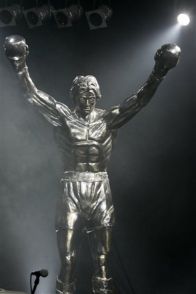 Rocky statue at evening unveiling ceremony, Zitiste, Serbia, August 2007. (AP Photo/Srdjan Ilic) 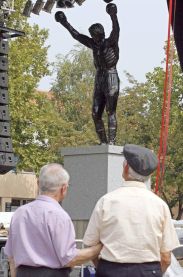 Rocky statue in town square, Zitiste, Serbia. (Reuters photo) The Rocky statue that now graces the village square of Zitiste is similar to, but is not a copy of the Rocky Balboa statue at the Philadelphia Art Museum. |
![Earlier base plate on the Rocky statue with inscription: "Thunder In His Heart. The Character Who Represents The Courageous Spirit of the Great City of Philadelphia And The Brotherhood of It's [sic] People." Earlier base plate on the Rocky statue with inscription: "Thunder In His Heart. The Character Who Represents The Courageous Spirit of the Great City of Philadelphia And The Brotherhood of It's [sic] People."](/wp-content/uploads/2009/07/rocky-statue-plaq-2.jpg)
Earlier base plate on the Rocky statue with inscription: "Thunder In His Heart. The Character Who Represents The Courageous Spirit of the Great City of Philadelphia And The Brotherhood of It's [sic] People."
An earlier plaque at the base of the Philadelphia Rocky statue (since removed) had labeled it “Rocky,” crediting A. Thomas Schomberg as its sculptor. And for a time, it also carried the following additional inscription: “Thunder In His Heart. The Character Who Represents The Courageous Spirit of the Great City of Philadelphia and The Brotherhood of It’s [sic] People.”
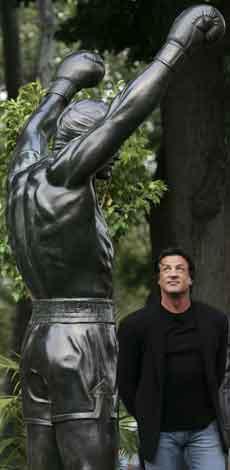
Sylvester Stallone with his Rocky likeness in Philadelphia at the 2006 ceremony.
A third large Rocky by Schomberg was also planned but not cast, as it was listed on eBay at various times in 2003-2005, being auctioned to raise funds for a proposed International Institute for Sport and Olympic History at State College, PA. The eBay notice initially listed a starting bids for the project, but it is not known if the third Rocky statue was finally cast and/or sold.
In addition to the monument-scale Rocky statues, a number of smaller replicas were made available for purchase through a collaborative venture between Schomberg and MGM film studios.
In 2006 at the 30th anniversary of the first Rocky film, two smaller sizes of the Shomberg Rocky were made available: a 12-inch sculpture cast in resin and hand painted for $98; and a 20-inch sculpture cast in resin, bronze plated, and hand painted at $468.00. In addition, a limited number of the 20-inch sculptures, cast in traditional bronze and mounted on a black marble base, were also made available, signed and numbered, at $2,600.00 each. There are also smaller, desk-top versions of the Rocky statue available on-line through various vendors, including the Philadelphia Art Museum.
“Rocky Dollars”
|
The Rocky Films Rocky (1976) (click titles for Prime Video) |
The Rocky name and business franchise, meanwhile, have done quite well over the last 40 years. The six Rocky films alone have had a worldwide box office of more than $1 billion, with about half of that generated in the U.S. Rocky IV, with its $300 million global box office, is considered the most financially successful sports film of all-time. And with Creed holding its own in 2015-2023, the series appears to be maintaining its momentum. The nine films together have grossed nearly $1.8 billion worldwide to date.
In addition to box office revenue, there is probably at least another $100-to-$200 million from sales of books, soundtracks, DVDs, video games, and other Rocky-related merchandise over that same time period. Rocky music and the film soundtracks, all by Bill Conti, have also done well. The main theme song in the 1976 Rocky, “Gonna Fly Now,” hit No. 1 on the Billboard Hot 100 in early July 1977.
Back in Philadelphia, meanwhile, the Rocky statue appears to be earning its keep. As one entry from the History.org website by Ron Avery explains:
“…[T]here is no debate among tour guides regarding the lasting fame the Rocky saga brought to Philadelphia and to the Philadelphia Museum of Art. Thousands still climb the steps and strike a Rocky-like pose. And by now there are countless cellphone snapshots of visitors posing alongside the bronze boxer. Few foreign visitors know or care about Betsy Ross, Carpenters’ Hall, or Oney Judge, but their eyes light up in recognition when they see the Museum’s steps and the statue of Rocky near the base.”
According to a 2023 post at Jim Murphy’s RealPhillyHistory blog, some experts estimate four million people a year now visit the “Rocky Steps” – only exceeded by the Liberty Bell & Independence Hall.
Rocky Update
Given the uproar and long-running debate that occurred in Philadelphia over the appropriate location of the Rocky statue – with the Philadelphia Art Museum location being at the center of that storm for some 20 years – it is interesting to note that in March 2014, the museum served as the host location for a cocktail reception and special screening of the latest edition of the 1976 Rocky film (see invitation below). In early 2014, Twentieth Century Fox released a brand-new 4K Blu-ray set of the Rocky movies — The Rocky Heavyweight Collection — and to celebrate, the Philadelphia Museum of Art opened its doors to Rocky fans for a special screening of the film and reception with the film’s director John G. Avildsen.
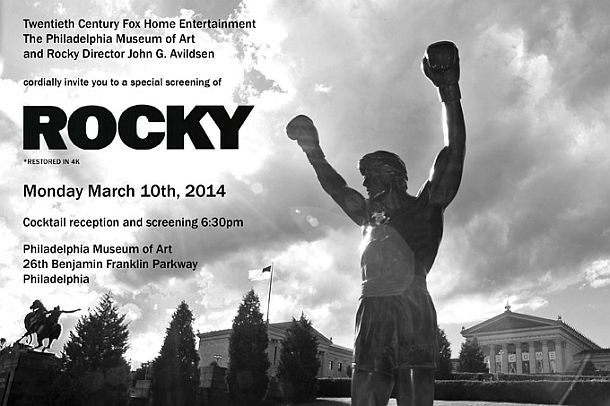
March 2014: Invitation to a special screening of the 1976-77 “Rocky” film at the Philadelphia Museum of Art.
Avildsen had filmed the original movie in 28 days, ten in Philadelphia and the rest in Los Angeles. Avildsen also won the Best Director Oscar, and Rocky took Best Picture that year – against competition that included: Taxi Driver, Network, All the President’s Men, and Bound for Glory. Still, the Museum of Art became known for its stand-offish reputation with regard to Rocky. So, the March 2014 reception and special screening marked something of a change. “The trick for the Art Museum,” noted Philadelphia Inquirer columnist Karen Heller, a few days after the screening, “is to capitalize on Rocky and draw new patrons inside. Showing the movie, finally, is a start.”
“We thought we would celebrate the original film and the original director, and bring Rocky up the steps and inside the museum,” said museum president Gail Harrity to columnist Heller. “The Rocky story is an iconic film known worldwide, and this is one of the great film sites that happens to be a world-class museum. A lot of people here have never been inside.” Indeed. As veteran museum guide Deena Gerson noted to the Inquirer’s Heller: “If that statue was brought inside, given that there are always lines of people, we would be one of the wealthiest museums in the country.”Meanwhile, in Stallone’s 2015 installment in the Rocky film series with Creed, the two main characters – Rocky (now a manager), and his boxer charge, Adonis (Donnie) Johnson – after returning to Philadelphia, make their way up the Philadelphia Art Museum’s steps to gaze out on the city’s skyline. …Stay tuned, Rocky is still in the building.
See also at this website, “Philadelphia Morning,” about the Rocky film segment and music of that name – and other Bill Conti music from the 1976 film that helped make it such a big success. For other stories on boxing history at this website, see: “Ali-Frazier History,” covering the 1971 and subsequent Muhammad Ali-Joe Frazier fights and related background, and, “Dempsey vs. Carpentier,” a profile of the that historic July 1921 championship bout and the role radio played in bringing a major sporting event to large mass audience for the first time. See also the “Film & Hollywood” category page or the “Annals of Sport” page for stories in those categories. Thanks for visiting – and if you like what you find here, please make a donation to help support this website. Thank you. – Jack Doyle
|
Please Support Thank You |
________________________________
Date Posted: 20 July 2009
Last Update: 23 November 2023
Comments to: jackdoyle47@gmail.com
Twitter: https://twitter.com/PopHistoryDig
Article Citation:
Jack Doyle, “The Rocky Statue: 1980-2009,”
PopHistoryDig.com, July 20, 2009
________________________________
Film/Video at Amazon.com…
Sources, Links & Additional Information
“Sly Urges Statue To Look Up To,” Philadel-phia Daily News, December 11, 1980, p. 42.
Clark DeLeon, “The Scene,” Philadelphia Inquirer, March 16, 1981, p. D-2.
Sal Vittolino, “A ‘TKO’ For Rocky; Two Locations Eyed for Statue,” Philadelphia Evening Bulletin, November 20, 1981.
William Robbins, “Rocky’s Homecoming Hailed; Statue Fight Ends in a Draw,” New York Times, May 25, 1982, p. A-16.
W. Speers, “Stallone Resurrects That Statue Matter,” Philadelphia Inquirer, January 9, 1990.
Clark DeLeon, “Statues: Readers Rage Over Rocky,” Philadelphia Inquirer, February 21, 1990, p. B-2.
Mark Fazlollah, “Statue of Rocky to Leave the Art Museum – Again,” Philadelphia Inquirer, February 25, 1990, p. B-3.
Gloria Campisi & Mark McDonald, “Steps in the Right Direction, ‘Rocky’ Going Back to Museum, but Not to Famous Spot,” Philadelphia Daily News, May 11, 2006.
Stephan Salisbury, “Comeback for Rocky Statue,” Philadelphia Inquirer, May 11, 2006.
“‘Rocky’ Statue May Fight Again,” Los Angles Times, May 12, 2006.
Editorial, “Has Rocky Found a Home?,” Philadelphia Inquirer, May 12, 2006.
“Philadelphia Officials Reject Rocky Statue for Art Museum,” CBCNews.ca, Friday, August 4, 2006.
Scott Weinberg, “Rocky Wins Battle With Snooty Art Critics … Kinda,” Cinematical, August 24, 2006.
“Rocky Statue Returns to Philadelphia Art Museum,” CBC Radio, Canadian Broadcasting Corporation, Wednesday, September 6, 2006.
Editorial, “Rocky’s New Home,” Philadelphia Inquirer, September 9, 2009.
Ron Avery, “Philadelphia Oddities – Rocky Statue,” USHistory.org
“Rocky: The Monumental Statue,”Schomberg Studios.com.
“A. Thomas Schomberg,” Profile.
“Rocky Film Series,” Wikipedia.org.
“Rocky Statue on eBay,” Posted by David Pescovitz, May 29, 2005.
National Public Radio, “‘Prop’ Culture? Rocky Statue Blurs Art Line,” All Things Considered, July 30, 2006, Joel Rose reporting, NPR Member Station WHYY in Philadelphia, PA,
Stephan Salisbury, “Will City K.O. Rocky’s Bid for O.K.?,” Philadelphia Inquirer, August 3, 2006.
Clark DeLeon, “Obstructed View of Rocky,” The Daily Deleon, September 9, 2006.
Associated Press, “Rocky Statue Headed Back to Museum Steps; Philadelphia Art Com-mission Votes to Return Boxer to Original Locale,”MSNBC.com, Wednesday, September 6, 2006.
Michael Vitez, “Stallone — and Thousands — Cheer Rocky Statue,” Philadelphia Inquirer, September 8, 2006.
Joann Loviglio, Associated Press, “Rocky Balboa Statue Causes Controversy,” Sep-tember 14, 2006.
Robert Strauss, “Rocky Statue Makes Comeback at Museum,” New York Times, November 19, 2006.
“Serbian Village Venerates Rocky,”BBC News, February 12, 2007.
“Rocky Statue Draws Crowds in Serbia,” Independent Television News (U.K.), Sunday, August 19th, 2007.
Associated Press, “Serbian Village Gets Rocky Statue,” USA Today, August 20, 2007.
Daniel Rubin, “Piece Of The Rock,” Blinq. The Philadelphia Inquirer, November 5, 2006.
“Running in Rocky’s Famous Footsteps,” National Public Radio, November 22, 2006.
Karen Heller, Philadelphia Inquirer, “Rocky – The Movie – Finally Makes it Inside the Art Museum,” Philly.com, March 13, 2014.
Laura. Holzman, “A Question of Stature: Restoring and Ignoring Rocky,” Public Art Dialogue, October 2014, pp. 249–265.
Jim Murphy, “It’s a Knockout! ‘Rocky Statue’ is Still a Huge Hit in Philly,” RealPhillyHistory.com, November 20, 2023.
More Stallone…

